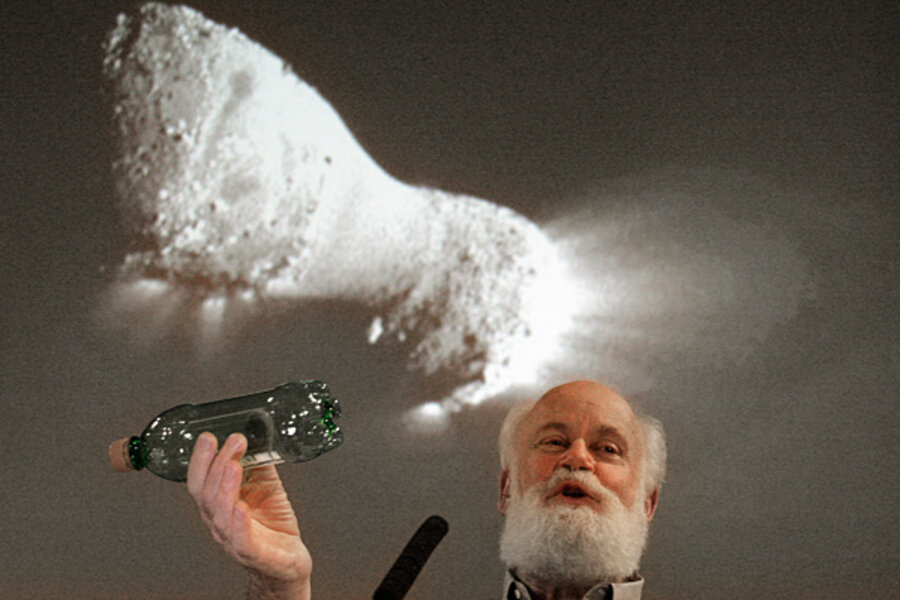Comet Hartley 2 flyby yields stunning photos of a cosmic oddball
Loading...
If you've visited Washington, D.C., and walked the length of the Mall between the Capitol and the Washington Monument, congratulations: You've sauntered the length of 103P/Hartley 2, a comet humans saw up close and personal for the first time Thursday.
NASA's EPOXI spacecraft buzzed past the comet at around 10 a.m. Eastern Daylight Time, marking only the fourth time that planetary scientists have been able to get a good look at a comet's nucleus – a lump of rubble and ice that dates from the dawn of the solar system some 4.5 billion years ago.
Researchers are keenly interested in these objects not only for what they can reveal about conditions in the early solar system. Comets also are thought to have provided many of the chemical building blocks that led to life on Earth – from organic molecules to water.
The pass by Hartley 2 is expected to provide the most extensive set of images and spectra yet taken of the heart of a comet. It's the first time images have been taken with a camera sharp enough to allow scientists to link jets of dust and gas with specific features on the surface of the nucleus, providing deeper insights into the processes sculpting these objects.
120,000 images to come
For the science team, pinning down the length of the pickle-shaped Hartley 2 may be one of the few conclusive pieces of information they can share so soon after the encounter. It will take years to wade through the expected 120,000 highly detailed images EPOXI will take before controllers shut off its cameras around Thanksgiving.
Five moderately detailed pictures taken during closest approach to the comet, which the team downloaded from the spacecraft shortly after its encounter, are providing a start.
During a briefing this afternoon, researchers unveiled a comet nucleus that sports two rough, bulbous ends joined by a relatively smooth wasp-waist middle, perhaps representing a kind of dell in the comet's midsection that over time has filled in with dust. As it approaches the sun and heats up, the comet is venting dust and gas from the sunlit portion to the night side – and along the day-night boundary in between.
Previous missions had suggested that venting occurs not just on the warm, sunlit portions of a comet's surface, but on the frostier darkened portions as well. EPOXI has provided the definitive evidence that this does happen, the team says.
The spectacular show comes with a cost. With each pass around the sun (once every 6-1/2 years), the comet loses three to four feet of its surface through this venting process, says Michael A'Hearn. a planetary scientist at the University of Maryland at College Park and the mission's lead scientist.
Hartley 2 is too small to sustain those losses and hang around for too many more years, Dr. A'Hearn suggests.
EPOXI already has one comet under its belt. Under the moniker Deep Impact, the recycled spacecraft visited 9P/Tempel 1 in 2005. After that encounter, however, the craft still had plenty of fuel and its hardware was functioning perfectly.
A comet oddity
The team picked Hartley 2 as a second target because of its unusually small size and high level of venting compared with other comets spacecraft have visited.
Even before Thursday's encounter, Hartley 2 was surprising scientists with its odd, still-unexplained behavior. For instance, EPOXI detected Hartley 2 venting cyanide in a process that increased over about five days, peaked for another five, then decayed over another five days. Usually an expulsion of dust and gas appears suddenly, then fades with time.
"We've never seen that before," A'Hearn says of the 15-day show.
Moreover, the gas given off by Hartley 2 is dominated by carbon dioxide – suggesting that the object hosts a lot of dry ice beneath its surface. With other comets, water appears to be a major component of the gas.
"We have a lot of work to do to try to understand what's going on here," says Jessica Sunshine, also from the University of Maryland and the mission's deputy lead scientist.
As for the EPOXI spacecraft, it lacks sufficient fuel to target another comet, engineers say. But the needle is not yet on empty, and its cameras are still in good shape and available for another mission.
NASA officials say they are polling the space-science community now for ideas on how to take additional advantage of the spacecraft. During its five-year travels from from Tempel 1 to Hartley 2, EPOXI served as an additional tool in the hunt for planets orbiting other stars, for instance.





